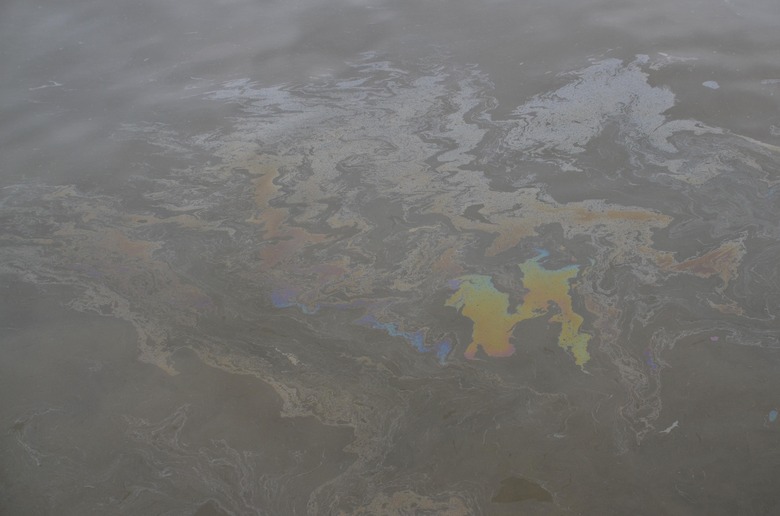The Effects Of Oil Pollution On Aquatic Ecosystems
When oil is spilled into an aquatic environment, it can harm organisms that live on, around, and under the water surface by both chemical toxicity and by coating and smothering wildlife. This has both short-term and long-term effects on all parts of the marine food web, including long-term damage to breeding and migration habitats that affects future generations of marine life. Short-term effects vary with the type of environment, amount of oil, effect of waves and weather, and type of oil: light, medium or heavy.
Offshore and Coastal Waters
Offshore and Coastal Waters
The loss of predators has a cascade effect on ecosystems, and offshore, the most vulnerable species are those found on the sea surface. Since most oils float, the creatures most affected are surface predators, such as sea otters and seabirds. National Oceanic and Atmospheric Administration studies have found that oil destroys the water-repelling abilities of fur and feathers and their ability to trap warm air when they become coated and matted. As a result, marine mammals and seabirds can lose their buoyancy and die of hypothermia. If they ingest it, it can cause kidney, liver, and lung damage. Benthic species, such as reptiles and fish found in offshore waters, can also ingest oil and suffer from organ damage, and reproductive impairment, and can transmit oil toxins to predators that eat them. With top predators absent, fish fry numbers increase and ravage the grazers that keep algae growth in check. This allows lush algal mats to grow and take up valuable oxygen from the water when they decompose, suffocating other animals in the ecosystem.
Shallow Inshore Waters
Shallow Inshore Waters
Invertebrates like sea stars and coral play an essential role in ocean ecosystems, where they serve as keystone species or foundation species. Keystone species are those that provide an essential link in the food chain that influences both predators and prey, and foundation species like coral create and maintain a habitat for other species. With the loss of just one species of sea star from the inshore waters of an island in Washington, mussels quickly moved in and crowded out other species, drastically altering the ecosystem. Corals, sea stars, and sea grass all inhabit shallow inshore waters, and can become coated and smothered by an oil spill. Sea stars are covered by tiny hair-like cilia which help transport water into their vascular organs. When the cilia and internal organs get coated with oil, it can lead to degraded function and death of the sea star. In areas where oil has been allowed to settle on coral, like the recent spill in the Gulf of Mexico, it can reduce photosynthesis, cause tissue damage and even lead to death. Long-term effects are still being determined, but without a healthy coral reef, the gulf could lose the many species that depend on the reef for food and protection.
Shorelines
Shorelines
Some of the most far-reaching damage of oil spills happens near shorelines. This is an area used as the nesting or breeding grounds for the next generation of sea life. Many species spend most of their lives at sea, but must come ashore to breed or give birth. Sea turtles and marine mammals can be harmed by oil they encounter in the water or on the beach where they give birth. The eggs or pups can be damaged by the oil and fail to develop properly, and new young may be oiled as they scurry toward the ocean across an oily beach. A loss in the number of sea turtles could even affect the health of its breeding ground, like the sandy beaches and dunes of the Florida sea turtle. Any unhatched eggs provide a great source of nutrients for the dune vegetation. As plants become stronger and healthier, their root systems help hold the sand in place, decreasing erosion and strengthening this important ecosystem.
Mangroves/Salt Marshes
Mangroves/Salt Marshes
One of the marine habitats most vulnerable to environmental change is the mangrove forest. Oil spills that coat the exposed roots of mangrove trees can plug up the air-breathing pores, or lenticels, and suffocate the trees. Mangrove roots stabilize the sediment and prevent erosion of coastlines, keeping sediment from being deposited on nearby eel grass beds or coral reefs. They also provide a buffer to inland areas from devastating hurricane winds and storm surges. Mangrove forests and salt marshes provide important habitat for migrating birds, and a nursery area for fish and shrimp. The whole mangrove environment can be killed by an oil spill, with dire consequences, not only to marine life, but to humans living near these protective ecosystems.
References
- National Oceanic and Atmospheric Administration: How Oil Harms Animals and Plants in Marine Environments
- National Oceanic and Atmospheric Administration: Oil spills can be very harmful to marine birds and mammals as well as fish and shellfish
- U.S. Environmental Protection Agency: The Behavior and Effects of Oil Spills in Aquatic Environments
- The International Tanker Owners Pollution Federation Limited: Effects of oil pollution on the marine environment
Cite This Article
MLA
Wiedenhoft, Heather. "The Effects Of Oil Pollution On Aquatic Ecosystems" sciencing.com, https://www.sciencing.com/effects-oil-pollution-aquatic-ecosystems-11390/. 24 April 2017.
APA
Wiedenhoft, Heather. (2017, April 24). The Effects Of Oil Pollution On Aquatic Ecosystems. sciencing.com. Retrieved from https://www.sciencing.com/effects-oil-pollution-aquatic-ecosystems-11390/
Chicago
Wiedenhoft, Heather. The Effects Of Oil Pollution On Aquatic Ecosystems last modified August 30, 2022. https://www.sciencing.com/effects-oil-pollution-aquatic-ecosystems-11390/
